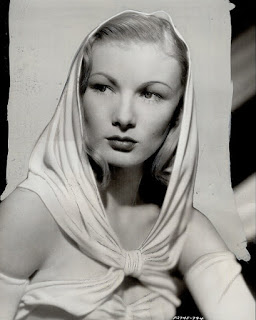“Noir is almost always about paranoia, eavesdropping, being spied on, loners and how do you catch them,” film noir expert, Dr. Foster Hirsch of Brooklyn College, tells The Creators Project. “What changes is, of course, state of the art. Technology is so different now than it was in the immediate post-war period. We’re more sophisticated. And I think what that does is it creates a greater sense of solitude and privacy and that is a breeding ground for pathological noir characters.”
The ubiquity of cell phone cameras and the nonchalance of modern day surveillance allow us to live out the narrative that classical noirs of the 40s and 50s foreshadowed. Today we’re living in the most epic of noir films, where modern technologies allow every person to record and be recorded, where surveillance is an afterthought, and no one seems to mind. Classic noirs from the Red Scare illustrate this permeable sense of unease. But now, according to Dr. Hirsch, “Everyone is under surveillance and you don’t suspect the communists as in the past, it can be anyone. [There is] no privacy. People are afraid of identity theft, computers are vulnerable.” Therefore everyone is vulnerable. When Ebert wrote that article 20 years ago, only 9% of Americans used computers daily, today only 15% don’t.
“Technology and noir have a long history together,” Hirsch continues. “Technology changes, but it doesn’t change the narrative patterns of the noir genre.” In fact, it heightens them. We’ve known for years now that technology has the potential to isolate, and that isolation breeds all those nasty inner demons that are generally checked by adequate and healthy socialization in childhood and adolescence. But did we ever consider that we are the personified products of a neo-noir lifestyle? John Donne’s famous poem, "No Man is an Island," now seems eerily prescient and a creed to revisit.
According to Ebert, “Noir thrives on pessimism and fear—and on guilt, the feeling that we have ourselves to blame for our troubles.” The 21st century existence is one shaped by Snowden, Salgado, and widespread personal surveillance. One that feels inherently frenetic, highlighted by loss (of nature, privacy) and one that, were Ebert to have reassessed the noir genre before his death in 2013, plays perfectly into his hand. Source: thecreatorproject.vice.com
In Fight Club (1999), you have Edward Norton’s Narrator; in Mr. Robot, you have Rami Malek’s Elliot. They’re not so different: both want a different world, one free of the tyranny of giant corporations, but neither are sure how to go about changing it. They each live largely solitary existences, have damaged love interests, and keep charismatic revolutionaries as mentor-companions. They also share one other key trait: undiagnosed schizophrenia.
Mr. Robot took the template for Fight Club and did it better. Flagrant misogyny isn’t the only issue of Fight Club’s that Mr. Robot corrects in its version of the story. Where Mr. Robot has affection for its characters, Fight Club has little to none. Where Mr. Robot attempts to give the audience some understanding of social anxiety and mental illness, Fight Club uses it as a narrative device and—after the reveal—mines the Narrator’s schizophrenia for comedy.
I’ll go further and argue that Mr. Robot’s phenomenal Rami Malek makes for a more interesting lead than Fight Club’s Edward Norton, an actor likened to Robert De Niro despite never giving a performance to warrant such a comparison; that Mr. Robot makes violence appear abhorrent, whereas Fight Club appears to relish in it. Fight Club is a solipsistic, middle-aged male fantasy, where Mr. Robot is a more welcoming, earnest plea with the world to wake up and save itself. Mr. Robot’s premiere season in isolation remains Fight Club’s better, a more compassionate, genuine, open call-to-arms. It’s Fight Club 2.0, a 2015 upgrade for a new generation; it’s David Fincher’s alleged classic taken, improved upon, and perfected. Source: www.pastemagazine.com
Mr Robot has much that is stunning. Cinematographer Tod Campbell composes his shots with rigorous beauty, conveying Elliot’s isolation and paranoia with expanses of negative space washed in limpid blues and greys, pushing Malek’s body to one side like an afterthought. His other favourite shot is a close-up on Malek’s wonderfully expressive face. The Trent Reznor-ish musical score and the sound design that pushes Elliot’s rambling inner monologue to the fore are both superb. Best of all is Malek’s twitchy, intensely sympathetic performance as a damaged genius trying and failing to connect. Source: www.metromag.co.nz
Imagine a fast-moving computer game set in the black-and-white environment of a 1940s detective movie and you'll begin to get some idea of the mixed metaphors that fill the air in K.W. Jeter's difficult but ultimately rewarding futuristic thriller. Jeter, who also writes a series of novels based on the popular Blade Runner film about apocalyptic Los Angeles, centers Noir in that same city, now a dark jewel of the dominant Pacific Rim. A detective named McNihil has had his eyes surgically altered so that everything looks like an early Bogart movie to him. "Gray newspapers with significant headlines--'Dewey Defeats Truman,' 'Pearl Harbor Bombed'--moldered in the gutters, or were nudged along the broken sidewalks by the same night wind that cut through McNihil's jacket," Jeter writes about the scene of a plane crash where the detective has been summoned by a corporate villain. Aided by a young woman called November, whose fingertips are alive with lethal magnetic currents, McNihil brings his--and Jeter's--unique noir vision to bear on a world that for all its weirdness is the ultimately believable extension of our present-day nightmares. —Dick Adler Source: www.thrillingdetective.com
The living woman’s name was November. Not the name her mother had given her, but the one she’d given herself and that her friends, when she’d still had a pack to run with, had endorsed as fitting. Snow touched her brow, whiter than the yellow-tinged bone beneath the dead woman’s parchment skin. Ice walked through the ventricles of her heart and down her pale arms, not as an indication of cruelty —for she wasn’t cruel, even when her living came at the price of others’ breath —but as the metaphor of sadness. When she had nothing better to do — when she was far enough ahead in her accounts that she didn’t have to worry about her own death, at least for a little while— she could ride down to the bottom of the Gloss, to the Pacific Rim’s southern crossing, where the trains worked their way across ice floes and polar fields, past the great sliding glaciers and over the storm-lashed seas. November felt sorry for the man —his name was McNihil— in her usual, nonempathic way. An intellectual process, like watching one ice floe grind implacably against another, the white fields cracking and splintering as though alive but not sentient. To be fatal and noncaring at the same time; it just worked that way. The ice surged and hammered against itself. —"Noir" (1999) by K.W. Jeter
Subscribe to:
Post Comments
(
Atom
)






















No comments :
Post a Comment